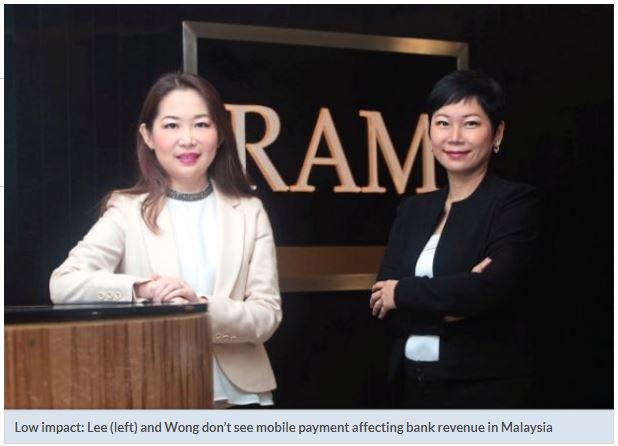Mobile payment deemed not a threat to banks in Malaysia
PETALING JAYA: The increasing popularity of mobile payment due to the high mobile penetration rate is not seen as a material threat to Malaysian banks, according to RAM Ratings.
In an email interview with StarBiz, RAM Ratings co-head of financial institution ratings Wong Yin Ching said such a mode of payment in the country is unlikely to attain the level of ubiquity that it enjoys in China.
This is because of the wider availability of other more established electronic payment methods such as credit and debit cards, she added.
Sophia Lee, who is also one of the co-heads of financial institution ratings at RAM, said even if increased payment volume via mobile wallets may reduce transactions via credit cards, the fee income earned from card transactions only accounted for a minor proportion of Malaysian banks’ overall earnings.
While a handful of mobile wallet providers (mobile payment players) have expanded into areas such as lending, RAM observes that the loan amounts are comparatively low and borrowers are usually small merchants and entrepreneurs that are typically not banks’ targeted clients.
The rating agency would soon be releasing its commentary on mobile payment in Malaysia.
RAM recognises that mobile payment is mushrooming throughout the world. China is the global hub for mobile payment while varying levels of adoption could be observed in other countries.
Although mobile payment is still budding in Malaysia, market competition is intense as Bank Negara has granted licences to 48 non-bank e-money issuers.
The central bank’s endeavour to promote mobile payment is consistent with its aspiration of building a cashless society, as embodied in the Financial Sector Blueprint 2011-2020.
Elaborating on the blueprint, Wong said: “It comprises a three-wave cashless transformation. The first wave had involved the displacement of cheques with electronic fund transfers (EFTs) and had met with considerable success.
“However, it remains to be seen for the second wave, which entails the displacement of cash with debit cards as debit card usage, while growing, has remained comparatively low.”
Harnessing the high rate of mobile phone penetration, she said the third wave of reform would rely on mobile payments to supplant cash and cheques.
To this end, the central bank has introduced the Interoperable Credit Transfer Framework (ICTF), under which all eligible mobile payment players would have to operate on a shared payment network known as the Real-time Retail Payments Platform (RPP) if they have reached a certain size.
Lee expects the RPP to be an enormous boon to mobile wallet users, as they could then have a single wallet that pays various mobile payment players operating via the RPP.
With the support of the central bank, mobile wallet providers made good progress in promoting this payment method as the number and value of non-bank mobile payment transactions had risen to a respective 31.1mil and RM1.3bil in 2018 (2017: 1mil and RM240.3 mil).
While this budding industry currently has 48 licence holders, Wong said only a handful dominate the field. Of these, almost all are owned or backed by high-profile businesses, she said. For instance, Touch ‘n Go eWallet is jointly-owned by CIMB and Ant Financial while Boost is the mobile wallet established by Axiata. Partnerships with banks are also common for many mobile payment players as they seek to expand their merchant bases.
That said, RAM noted that many mobile payment players are still loss-making as some do not charge merchants any payment processing fee at the outset. “Operating costs are also eye-watering for many players, who have to contend with outflows such as IT-related expenses and marketing expenditure to promote adoption,” Wong said.
As mobile payment is still in its nascent stage in Malaysia, many players are spending heavily on marketing campaigns such as complimentary vouchers, F&B discounts, and cash rebates on purchases.
For some players, she said, however, the mobile payment business is just a mean to other ends such as lending, data provision and distribution of third-party products.
Lee noted: “With the sheer number of players in a relatively small market and the fact that most are still in the red, we believe that industry consolidation is very likely,” The likely survivors, she said would be those with already substantive user and merchant bases, unique value propositions and deep pockets to ride through the cash burn and tide of consolidation.
“Penetration into the mom-and-pop economy is also important. Warungs, kopitiams, mamak stalls and pasar malams may well offer the best prospects to the future of mobile payment,” Wong added.
Source: https://www.thestar.com.my/business/business-news/2019/05/21/mobile-payment-deemednot-a-threat-to-banks/#QkP6O2WtZuMhqFOx.99


 English
English




